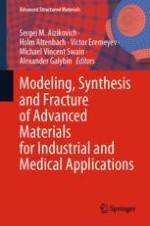2020 | Buch
Modeling, Synthesis and Fracture of Advanced Materials for Industrial and Medical Applications
herausgegeben von: Prof. Dr. Sergei M. Aizikovich, Dr. Holm Altenbach, Prof. Dr. Victor Eremeyev, Prof. Michael Vincent Swain, Prof. Alexander Galybin
Verlag: Springer International Publishing
Buchreihe : Advanced Structured Materials
